After a metal-detector signal has been pinpointed and a signal marker placed at the nearest part of the indication, the deminer can begin a signal investigation procedure.
If at any point during the procedure metal is found and it is not an explosive hazard, the deminer should stop the investigation and use the metal-detector search procedure to check the area where the metal was found and find out whether there are other signals.
If an explosive hazard is located, the deminer should expose the side of the device closest to the base-stick and follow the approved procedures for its disarming or destruction.
Hand tools approved for use during signal excavation should be blast resistant and be designed specifically for the purpose.

The picture above shows some of blast resistant hand tools. Any tool that is used in the ground during signal excavation should be blast resistant.
 Tools designed for gardeners may only be used for vegetation cutting. Tool designed for use in the building industry, such as cement trowels, must not be used.
Tools designed for gardeners may only be used for vegetation cutting. Tool designed for use in the building industry, such as cement trowels, must not be used.
The picture alongside shows the pressed steel head of a gardening trowel after it was recovered from inside a deminer’s thigh. The deminer had used the tool with too much force when investigating a metal-detector signal.
Short tools that separate in a blast event are known to have increased injury in many accidents and must not be used. Tools made using very hard materials can
shatter in a blast event, so must also be avoided.
Magnets
Strong (rare-earth) magnets can be very useful in areas where metal-detector search is used and there is a lot of metal contamination in the ground. The magnets may be attached to tools such as the light rake or trowel, or can be held in the hand. They should be brushed over the ground surface without downward pressure. The picture below shows a thin strip of polycarbonate with thin neodymium magnets taped to one end. This tool is light and keeps the user’s hand at least 30cm away from the magnets.
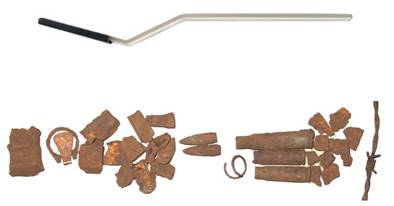
The photograph above shows typical minefield scrap metal. Most of the metal has a ferrous content, so it is magnetic. The only item that is not magnetic is the ring-pull from a drink can.
Locating small pieces of ferrous metal with a powerful magnet can speed up the signal investigation process very dramatically and so make it efficient to use metal-detectors in areas that are heavily contaminated with metal fragments. However, when an area is contaminated with many fragments that are beneath the ground surface, it may still be quicker to search the area using an area-excavation procedure.
NOTE: Never put a powerful magnet near the controls of a metal-detector because it could alter the settings or damage sensitive components.
Special tools for hard ground
When ground is exceptionally hard, a signal investigation may be started using a two-handed digging tool to break up the ground surface at least 20cm from the nearest part of the signal (the distance from the signal must be more than half the diameter of the largest anticipated target at the task). Digging down to the search depth in a safe place gives the deminer a point from which to work forward towards the signal using one-handed tools with less force.
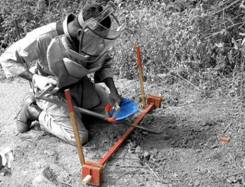 The deminer in the photograph on the left is using a two-handled tool to start the excavation well away from the metal-detector signal marker.
The deminer in the photograph on the left is using a two-handled tool to start the excavation well away from the metal-detector signal marker.
The tool is made using blast-resistant material and its design includes a guard for the hand that would be closest to any blast.
Slicing tools
When investigating a metal-detector signal or conducting area-excavation, there are times when the use of a tool that slices away the face of the excavation can be efficient and safe.
Excavation must be conducted using the procedures described below unless none of the anticipated targets are movement sensitive and none have pressure plates extending to the edge of the mine.
NOTE: Movement sensitive hazards include some armed submunitions and that must be excavated with the greatest caution.
Anti-personnel blast mines have pressure plates of various sizes. Pressure plates that are small make the mine less likely to be stepped on but they are used because they make the mine less likely to be detonated by the pressure wave associated with an air-blast nearby.

The GYATA-64 and PMN mines shown above have large pressure plates extending to the edge of the top of the mine. When these mines are anticipated, slicing away the face of an excavation should not be conducted. The face of the excavation should be crumbled away from the bottom upward.

The anti-personnel blast mines shown here are the MAI-75, PMN-2 and Type-72. In each case the pressure plate is smaller than the top of the mine and excavation using a cautious slicing procedure may be permitted.
Signal investigation procedure
Metal-detector signals should be investigated using the procedure described below.
1. The deminer must begin by looking closely at the ground surface for sources of the metal-detector signal. If any metal is found, the deminer should remove the metal and check the signal position with the metal-detector. Throughout the investigation, the deminer should be constantly looking for the source of the metal-detector signal.
2. When magnets are available, the deminer should pass a magnet over the ground surface where the metal-detector signalled. The signal marker may be temporarily removed for this. When approved, the REDS ‘Light rake’ with a magnet may also be used for this. After a magnet is used, the deminer should check the area with the metal-detector again.
3. An investigation should be started by prodding into the ground at least 20cm back from the signal marker. In most ground, the prod will not penetrate more than a few centimetres. The deminer must not apply excessive pressure to make the prodder go more deeply into the ground. If the prodder will not penetrate 3cm, the deminer should use an approved two-handed tool to break the ground surface. Sometimes the ground has a crust with softer spoil underneath. Frequently the ground becomes harder as the investigation gets deeper, and the use of other two-handed tools may be required.
4. The ground should be prodded or broken-up over a width of excavation equal to the width of the anticipated explosive hazards at the site. If anti-personnel mines are expected, a width of 15cm is required. If anti-tank mines are expected, a width of at least 30cm is required.
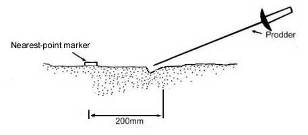
5. The ground that has been loosened with the prodder should then be removed with a trowel.
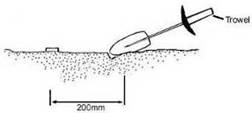
Whenever metal is found during the excavation, with the magnet or by eye, the deminer should check the position of the original signal with the metal-detector.
6. Steps 3 and 4 should be repeated as many times as necessary to create a sloping hole at least 15cm wide advancing towards the signal-marker. The depth of the hole should reach the required search depth at the site before the marker is reached.

The side of the excavation closest to the marker is approximately vertical. This should be prodded from the bottom upward at a spacing of 2cm. The prodded earth can then be removed with the trowel. When the prodder meets an obstruction, the prodder should be used to feel for the sides of the obstruction and so estimate its size. The trowel should then be used with extreme caution to expose the side of the obstruction.

Although lightly tapping an obstruction with the prodder can sometimes provide feedback to confirm that the object is likely to be a mine. The deminer must expose any obstruction with extreme caution, regardless of the ‘feedback’ from the prodder.
The fuze of the OZM-72 bounding fragmentation mine shown here had become buried by silt deposited by floodwater. The excavation approach shows a gentle slope getting deeper as the signal is approached.
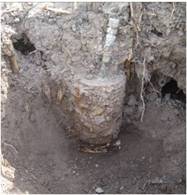
The deminer increased the depth of the excavation while maintaining a gently sloping approach as soon as the top of the mine had been exposed.
There was an ML-7 anti-lift booby trap beneath the mine, so the excavation had to be deep enough to show the bottom of the mine before both devices could be safely destroyed.
7. If no obstruction is found at the signal-marker, the deminer should check the position of the signal with the metal-detector. When the metal-detector continues to signal over the area, it may be appropriate to excavate more deeply. The supervisor should decide this based on the Task Risk Assessment and any pattern of mines that may be known.
Generally, when a mine is missing from an anticipated pattern and there is a metal-detector signal near where the mine was expected, the depth of excavation should always be increased up to a depth of twice the required search depth at the task. When hazards other than mines are being sought, the excavation should continue at least 10cm beneath the search depth for the task.
When searching more deeply, the deminer should start excavating again, beginning further away from the signal and extending the slope of the hole so that any hidden device will still be approached from the side.
Further information about excavating safely, the use of rakes for metal-detector signal excavation and area-excavation are described in Chapter 6 of the Global SOPs.
Some
groups only issue one tool for investigating metal-detector
readings. Usually the single tool is a bayonet or thin probe,
but sometimes it is a trowel. Clearly, it is not possible to
move spoil aside with a thin probe, and it is not possible to
probe with a trowel, so the safety of an excavation is compromised.
When that happens, severe injuries that require surgical amputation
occur.

The
user's hands only have to be 30cm away from the blast to avoid
the worst of these injuries.
The best way to achieve distance from an excavation is to use long handled rakes designed for the purpose.
Return to Introducing demining.